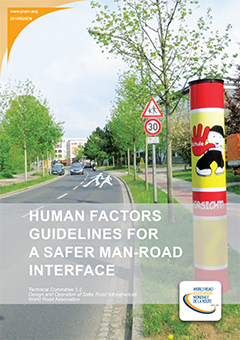Human factors guidelines for a safer man-road interface

In the case of road safety, the Human Factors concept considers road characteristics that influence a driver's right or wrong driving actions. It understands the causes of road users' operational mistakes as the first step in a chain of actions which may proceed to an accident. Many often observed operational mistakes result from a direct, subconscious interaction between road characteristics and road users' threshold limit values of perception, information processing and action. Because the driver's reaction characteristics can-not be changed, attention should be focused on a self-explaining road design.
This guideline explains the relationship between several road characteristics that trigger wrong perception and therefore also wrong driving reactions, most of which happen subconsciously.
Detailed examples and sketches allow the engineer to understand the relationship between misleading and irritating road character-istics and operational mistakes. They can be used as a kind of checklist in "on-the-spot" investigation of black spots or single vehicle accidents or in road safety inspections (RSI). They can also be used to qualify planning and design processes in road safety audits (RSA).
Information sheet
- Date: 2016
- Author(s): Comité technique 3.2 Gestion des risques liés aux routes / Technical Committee 3.2 Risk management for roads
- Domain(s): Road Safety
- Type: 2016R20EN - Technical Report
- PIARC Ref.: 2016R20EN
- ISBN: 2-84060-408-2
- Number of pages: 78